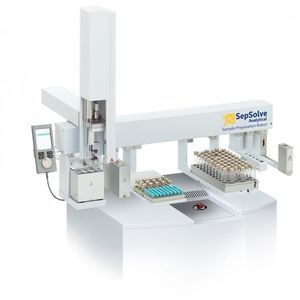

- Products
- Catalogs
- News & Trends
- Exhibitions
Automated laboratory extractor SPMEsolid-phaseavec fibre en polymère
Add to favorites
Compare this product
fo_shop_gate_exact_title
Characteristics
- Operational mode
- automated
- Options
- solid-phase, avec fibre en polymère
Description
Solid-phase micro-extraction (SPME) uses a polymer-coated fiber to extract and concentrate VOCs and SVOCs from the headspace above a sample, or from an aqueous-phase sample. The fiber is then removed and desorbed in the inlet of the GC or GC–MS. It is most commonly used for analysis of flavours, fragrances and odours in the food, beverage and consumer products industries.
WHY USE SPME?
A variety of extraction phases for SPME fibers enables sampling of a wide range of analytes.
Enhanced sensitivity compared to regular headspace sampling.
Elimination of solvent means reduced environmental impact.
Applicable to solid, liquid, and gaseous samples.
Fully automated using Sample Preparation Robots or Markes International's Centri® platform.
AUTOMATED SPME AND SPME–TRAP
Markes International’s fully automated Centri system allows unattended SPME sampling, with or without secondary re-focusing. Trap-based cryogen-free focusing results in enhanced sensitivity by allowing multiple extraction cycles from a single sample to be ‘concentrated’ in one GC–MS run, and results in improved peak shape and higher signal-to-noise ratios for the most volatile, early-eluting species.
APPLICATIONS
COMPARISON OF AROMA COMPOUNDS IN WHISKY BY SPME–GC×GC–TOF MS/FID
This study demonstrates the high performance of a flow-modulated GC×GC–TOF MS system, coupled with sample preparation by solid-phase micro-extraction (SPME), for the separation and identification of trace volatiles in three brands of whisky.
Related Searches
- Sample processor
- Automated sample preparation system
- Laboratory sample processor
- Benchtop sample processor
- Laboratory vial
- Glass vial
- Fully automated sample processor
- Modular sample processor
- Laboratory extractor
- Extraction sample preparation system
- Robotic sample preparation system
- Automated laboratory extractor
- Chromatography sample preparation system
- Solid-phase laboratory extractor
*Prices are pre-tax. They exclude delivery charges and customs duties and do not include additional charges for installation or activation options. Prices are indicative only and may vary by country, with changes to the cost of raw materials and exchange rates.






